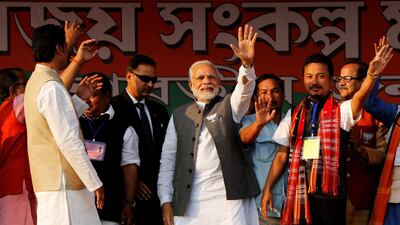Less than a month after he declared to the World Economic Forum that India was open for business, Prime Minister Narendra Modi has raised import duties to their highest in three decades, setting the stage for a protracted trade war.
As he prepares to seek re-election next year, Mr Modi has been ensnared by a global wave of protectionism that could threaten the foreign direct investments India needs to achieve double-digit growth. He has made it more expensive to import parts for automobiles, cameras, televisions, electricity meters and smartphones, risking trade disputes from allies like the US and Germany to rivals like China.
"India has taken a dramatic protectionist turn," Richard Rossow, an Indian policy expert at the Washington-based Center for Strategic and International Studies, wrote in a note. "The scale of India’s protectionist leap is surprising and likely to elicit a strong response from the United States and other major trading partners."
President Donald Trump signalled tit-for-tat duties against India’s barriers on motorcycles, while the German Ambassador to India, Martin Ney, questioned the decision to raise custom duty on the import of auto components. The US commerce department on Tuesday said it was examining imports of welded pipes from India and five other countries.
All this could add up to bad news for India at the World Trade Organisation (WTO).
"This can escalate at the WTO," said Rahul Shukla, Delhi-based executive director at PwC. "If they really want to help local industry there’s so much more that could be done, and it’s true that industry needs help. But these are the highest barriers we have seen in a long while."
India’s move comes as it faces the widest trade deficit in more than four and a half years and a resilient rupee. Data from the government on Thursday showed trade gap in January was $16.3 billion, the widest since May 2013. India’s yawning deficit with Asian powerhouse China is a matter of concern.
_______________
Read more:
India bank to close in South Africa amid Zuma controversy
India set to gain from major tourism push
_______________
Indian imports from China have soared in the past few years, outpacing exports and leaving the local industry, especially the medium and small sectors, gasping for survival. And exports from the $2.3 trillion economy have slowed at a time when the global economy is ticking higher.
Finance minister Arun Jaitley announced in his February 1 budget speech that the barriers would push the government’s flagship "Make in India" programme to encourage local manufacturing. Yet some believe the electoral costs incurred by Mr Modi after a chaotic roll out of the national goods and services tax - including significant disruptions to businesses - may have driven the government to resort to protectionism.
Indeed, a study by the Reserve Bank of India found the implementation and refund delays under the new tax regime had led to working capital constraints for firms, which in turn hurt exports in October 2017.
The barriers will remain in place for another two-to-three years to help small and medium companies, said Vanaja Sarna, chairwoman of India’s Central Board of Excise and Customs.
But the move may end up hurting local businesses, said Bipul Chatterjee, executive director at New Delhi-based think tank CUTS International.
"A hike of 15 to 20 per cent is not much for Chinese and South Korean companies - they can easily absorb it. This will end up hurting Indian competitiveness more than the government imagines," he said.

